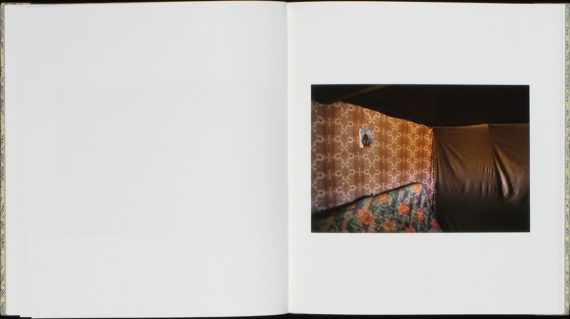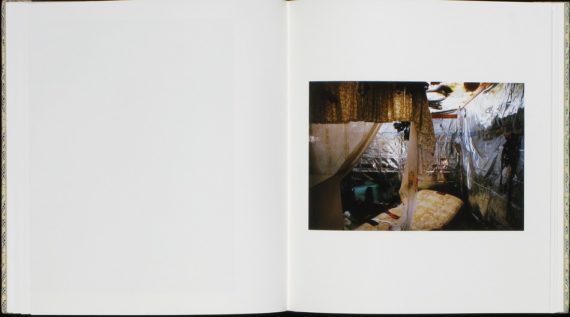Descrizione
Barone’s photographs are quiet and elegant, and one imagines that he was appalled by the marauders, perhaps especially when the vastly rich prime minister was reported to be on their side. One supposes that hearing about the riots and the black emotions that spawned them is in fact what brought Barone to explore the gypsies’ ruined houses, yet little of the violence is evident in the ruins, or even much that shows who once lived here, except insofar as a taste for rose patterns and heart – shaped pillows may seem vaguely Transcarpathian. The issues behind the rioting are large and important – xenophobiain Europe, the resentment the left-behind cities feel towards the globalized ones, with its speed and sheen – but such issues are not the subject of the pictures. The pictures seem smaller in their scope than the grand issues that they address. They are not specific to a district or a street, or even a house, or even a certain kind of room, but to one or another close corner in which a tired woman now gone who knows where once lovingly laid the bed, affixed some pleasing token to the wall, stood back to appraise what she had just done, setting her hands continually to lift the heart of the child, mate or sister with whom she lived.Their intimacy makes Barone’s work smaller than great issues, then – but in another way, it touches the biggest issue of them all. Really, the photographs are records of disappearance – of disintegration. Here is a splash of torn wallpaper, a shred of old curtain, a jettisoned pillow, yet if these objects seem to say a lot about the people who once lived their anxious, angry,laughing and disappointed lives among them, in truth they say very little. Who lived here? Whose place is this? One can hardly even imagine the answer; the photographs are ciphers. To my eyes, then, their truest subject is evanescence: the way,no matter how hard we work to institutionalize ourselves, everyone is finally erased. At times this may occur quickly or slowly,becoming ever less distinct and merging with every other person, until the only residue of a person is a name, if that, and he is more or less impossible to remember. The real subject of these pictures, I mean to say, is death itself.
Leo Rubinfien
Leo Rubinfien is an American photographer and essayist. His books include A Map of the East, Wounded Cities, Shomei Tomatsu / Skin of the Nation, and Garry Winogrand. His work has been exhibited at numerous museums and galleries,including the Metropolitan Museum of Art, the San Francisco Museum of Modern Art, the Cleveland Museum of Art, theSeattle Art Museum, the Corcoran Gallery of Art, Washington, DC, the National Museum of Modern Art, Tokyo, YaleUniversity Art Gallery and the Museum of Contemporary Art Rome, and will be exhibited in 2014-2015 by the Taka IshiiGallery, Tokyo, and the Steven Kasher Gallery, New York. From 2010-2015, he has also served as guest curator of the SanFrancisco Museum of Modern Art’s retrospective “Garry Winogrand,” which is touring among the National Gallery of Art,Washington, the Metropolitan Museum of Art, the Jeu de Paume, Paris, and the Fundacion MAPFRE, Madrid.
Aniello Barone was born in Naples in 1965, and after earning a degree in Sociology, he dedicated himself to the study of photography, with particular attention to the urban landscape, especially in the city’s outskirts and to the issue of immigration and subjects related to it. And these are precisely the themes in the publication of Sahrawi:la terra sospesa, ElectaNapoli, Napoli (2001), and La comunità accanto, Federico Motta, Milano (2001). The photographs in the latter consider the social status of immigrants from Asia, Africa, South America and Eastern Europe in Campania. Detta Innominata, Peliti Associates, Roma (2006), is a voyage into the post – industrial outskirts of Naples. Igboland, Five Continents, Milano (2011),is a project involving 12 years of work that investigates the animist rituals of the Igbo in Italy. The Italian edition of the book { } casa, Punctum Editions, Roma (2012) is a reflection on the transience of interpersonal relationships between men and their homes. Aniello Barone,Fotografie 1995-2013, Skira, Milano (2013) is a “summary” of his work initiated and prepared by the CSAC, University of Parma. He now teaches photography at the Academy of Fine Arts in Naples














